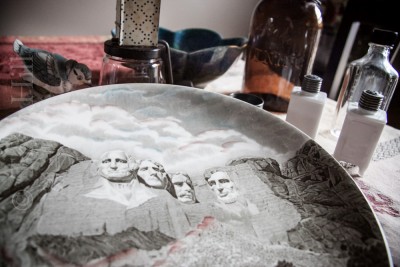 Normally, I wake up with some idea of what I want to tackle for the day. Today, that is photographing a bunch of items to put on eBay. Items from my wife’s deceased grandparents home. Wife’s aunt lived there as well. She passed away just over a week ago. The house is devoid of inhabitants now, empty of life, but full of stuff. And full of memories.
Normally, I wake up with some idea of what I want to tackle for the day. Today, that is photographing a bunch of items to put on eBay. Items from my wife’s deceased grandparents home. Wife’s aunt lived there as well. She passed away just over a week ago. The house is devoid of inhabitants now, empty of life, but full of stuff. And full of memories.
We’ve begun the cleaning process, the emptying of drawers, the sorting of papers, the discovery of memories long forgotten and small secrets that reveal the inner persons who lived there. My wife, her sister, and their mother touch many items with reverence as the memories surface. The cleaning of the home, the triggering and recovering of memories is a process that must occur as they prepare to part with the belongings and the structure they no longer need. But first, they need to find and release the memories attached to every item in the house.
The small home itself was built prior to WWII by wife’s grandfather and his friends. Nothing fancy. Doorways are framed with butt-end jointed trim, stained in a dark oak color. The cracked plaster of the ceiling shows a different pattern stamped into each room. A master woodworker, my wife’s grandfather was not. But the passion and commitment to craft his own home are evident.
A small home, a single story above a basement, with a tall attic above. A house from a time when the attic was potential living space. A staircase, hidden behind a door, stretches up toward an A-framed storage space. Lit by a single, small window in each end, and a bare bulb overhead. Here is where memories are stored. Old furniture, covered in dust, boxes of papers stand silently, waiting for attention.
An ornately framed document, a marriage license of a generation past, leans against a box. Behind the dust encrusted glass, the ink from the printing press is still dark black on the yellowed paper. The printed text swirls ornately to announce the marriage of two people who’s handwritten names are fading away, barely discernible. The date is slightly more readable. A quick spritz of glass cleaner, a swish of modern paper towel across the glass, then holding the framed document in the light of the kitchen window we can read the faded scrawling in the fill-in-the-blank sections between the professionally printed … June… “in the year of our Lord One Thousand, Eight Hundred and” … Seventy-three… My wife’s great-great grandparents.
The small, musty basement, with six or eight runs of clothesline, stretched between two 2x4s nailed to the floor joist overhead, is divided by simple, but somehow still fancy bookcase. It stands on the tile-over-concrete floor and stretches to the white painted floor joists and floorboard planks above. On one side of the hand-crafted bookcase wall is a small lounge area. A couch with 1960s course green fabric draped meticulously with a brightly colored flowered afghan stands in the area where my wife and her sisters often played on visits to the home. The backside is home to furnace and laundry. Near that stands a metal cabinet where their grandmother stored her home-made jams and jellies. A sewing machine, tucked into its wooden cabinet gathers dust next to the water heater.
The plain wood of the bookcase is trimmed in simple facing boards with curves and angles cut in a way to make the simple design seem ornate for a simple time. The craftsmanship wasn’t a rival for the artisans of the day, but, for a family struggling through the end of the great depression, the care of its creator is apparent in every curved cut of the simple trim boards.
One can see the sense of generation who had survived the rough economic times by looking down at the cabinet doors on the lower quarter of the bookcase. The structure is divided into two sections, each with a pair of cabinet doors. The door handles don’t match across the two sections. To the left, the two handles are metal, tarnished and worn. On the right section, white ceramic handles, with brass colored metal flanges, stand in stark contrast. Were the handles on one set of doors replaced after breaking? Or, did grandfather build them with the mismatched sets, because that is what he had available?
The memories they find are always bitter-sweet. The treasures of one generation pale in memory to the next generation. My wife and her sister struggle between two worlds as they work to clean out the house. The house they knew growing up. Their grandparents home. The house, crafted with care by its first owners, the grandparents, echoes with memories. Each item touched sets free another memory.